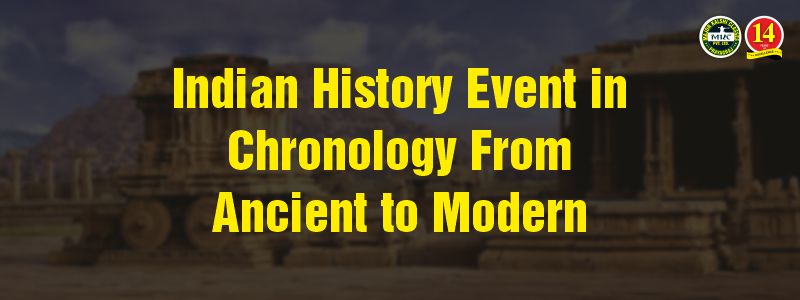Indian History Event in Chronology from Ancient to Modern
Indian History Event in Chronology:- Because of the cultures and civilizations that existed in this subcontinent, many people, including foreigners, are interested in Indian history. India’s history can be studied from a political, cultural, religious, or economic point of view.
Indian History Event in Chronology
Table of Contents
Chronologically, Indian History can be classified into three periods – Ancient India, Medieval India and Modern India.
Ancient India (Pre-historic to AD 700)
Proto-humans (Homo erectus) were active in the Indian subcontinent 20 lakh years (2 million years ago), and Homo sapiens have been present since 70,000 BC. They were, however, gatherers/hunters.
Tribals such as the Nagas (North-East), Santhals (East-India), Bhils (Central India), Gonds (Central India), Todas (South India), and others may have been the first inhabitants of the Indian subcontinent. The majority of them speak Austric, pre-Dravidian languages like Munda and Gondvi. Dravidians and Aryans are thought to be later immigrants to the subcontinent.
Based on the type of stone/metal tools people used, ancient India can be studied under different headings such as Paleolithic, Mesolithic, Neolithic, and Chalcolithic.
Palaeolithic Period (2 million BC – 10,000 BC)
- Fire
- Tools made up of limestone
- Ostrich Eggs
- Important Paleolithic sites: Bhimbetka (M.P), Hunsgi, Kurnool Caves, Narmada Valley (Hathnora, M.P), Kaladgi Basin
Mesolithic Period (10,000 BC – 8,000 BC)
- Major Climatic Change happened
- Domestication of animals ie Cattle rearing started
- Microliths found at Brahmagiri (Mysore), Narmada, Vindya, Gujarat
Neolithic Period (8000 BC – 4,000 BC)
- Agriculture Started
- Wheel discovered
- Inamgaon = An early village
- Important Neolithic Sites: Burzahom(Kashmir), Gufkral(Kashmir), Mehrgarh(Pakistan), Chirand(Bihar), Daojali Hading(Tripura/Assam), Koldihwa(UP), Mahagara(UP), Hallur(AP), Paiyampalli(AP), Maski, Kodekal, Santana Kaller, Utnur, Takkala Kota.
- NB: Megalithic Sites: Brahmagiri, Adichanallur
Period of the Chalcolithic (4000 BC – 1500 BC):-
- The Copper Age. Can be considered a Bronze Age period.
- Indus Valley Civilization (BC 2700 – BC 1900) (Bronze = Copper + Tin)
- Cultures can also be found in Brahmagiri, Navada Toli (Narmada region), Mahishadal (West Bengal), and Chirand (Ganga region)
Iron Age (BC 1500 – BC 200)
- Vedic Period (Arrival of Aryans ie. BC 1600 – BC 600) – Nearly 1000 years (Basic books of Hinduism, ie Vedas were composed, might have been written down later.)
- Jainism and Buddhism
- Mahajanapadas – Major Civilization after Indus Valley- On banks of river Ganga
- Magadha empire – Bimbisara of Haryanka Kula
- Sisunga dynasty – Kalasoka (Kakavarnin)
- Nanda empire – Mahapadma-nanda, Dhana-nanda
- Persian- Greek: Alexander 327 BC
Mauryan Empire (321-185 BC):-
Important rulers of the Mauryan Empire: Chandra Gupta Maurya, Bindusara, Asoka
Post-Mauryan Kingdoms (Middle Kingdoms):-
- Sunga (181-71 BC), Kanva (71-27BC), Satavahanas (235-100BC), Indo-Greeks, Parthians (19-45AD),
- Sakas (90BC-150AD), Kushanas(78AD)
- South Indian Kingdoms – Chola, Chera, Pandyas (BC 300)
Gupta Kingdom (300AD – 800AD):
Classical Period Important rulers of the Gupta Period: Samudra Gupta (Indian Napoleon)
Post Guptas or Contemporary Guptas
Harshvardana, Vakatakas, Pallavas, Chalukyas. Also, Hunas, Maitrakas, Rajputs, Senas and Chauhans.
Medieval India (AD 700 – AD 1857)
- AD: 800-1200: Tripartite struggle – Prathiharas, Palas, and Rashtrakutas
- Attack of Muhammed Bin Kassim (AD 712)
- Rise of Islam and Sufism
- Mohammed Ghazni (AD 1000-27)
- Mohammed Ghori (AD 1175-1206)
Delhi Sultanate (1206 AD – 1526 AD)
The following dynasties flourished one after the other during the Delhi Sultanate period.
- Slave Dynasty
- Kilji Dynasty
- Tuglaq Dynasty
- Sayyid Dynasty
- Lodi Dynasty
Mughals (AD 1526 – AD 1857)
- Great Mughals
- Later Mughals
Mughals from Babar (1526) to Aurangazeb (1707) were more powerful and hence known as Great Mughals. Mughals who ruled from 1707 to 1857 were known as Later Mughals.
- Arrival of Europeans
- Other Kingdoms of North India – Marathas, Sikhs
Modern Indian History Event in Chronology (AD 1857 +)
- First War of Indian Independence (1857)
- Formation of Indian National Congress (1885)
- Formation of Muslim League (1906)
- Non-Co-operation Movement (1920)
- Civil Disobedience Movement (1930)
- Quit India Movement (1942)
- Partition of India (1947)
- Constitutional Development of India (1946 – 1950)
- Economic Development of India
- Wars – India-Pak – Formation of Bangladesh; India- China
- New Economic Policy of 1991
- Nuclear, Space and Defense Development
List of the events is as follows;
List of the events is as follows;
|
Date |
Event |
|---|---|
|
1757 |
Battle of Plassey ensured the establishment of British political rule in India. |
|
1761 |
Third Battle of Panipat |
|
1764 |
Battle of Buxar |
|
1765 |
Clive was appointed Company’s Governor in India |
|
1767-69 |
First Anglo-Mysore War |
|
1780 |
Birth of Maharaja Ranjit Singh |
|
1780-84 |
Second Anglo-Mysore War |
|
1784 |
Pitt’s India Act |
|
1790-92 |
Third Anglo-Mysore War |
|
1793 |
The Permanent Settlement of Bengal |
|
1799 |
Fourth Anglo-Mysore War and Death of Tipu Sultan |
|
1802 |
Treaty of Bassein |
|
1809 |
Treaty of Amritsar |
|
1829 |
Practice of Sati prohibited |
|
1830 |
Raja Rammohan Roy visits England |
|
1833 |
Raja Rammohan Roy Died at Bristol, England |
|
1839 |
Death of Maharaja Ranjit Singh |
|
1839-42 |
First Anglo-Afghan War |
|
1845-46 |
First Anglo-Sikh War |
|
1852 |
Second Anglo-Burmese War |
|
1853 |
First Railway line opened between Bombay and Thane and a Telegraph line in Calcutta |
|
1857 |
First War of Independence taken place in India |
|
1861 |
Birth of Rabindranath Tagore |
|
1869 |
Birth of Mahatma Gandhi |
|
1885 |
Foundation of Indian National Congress |
|
1889 |
Birth of Jawaharlal Nehru |
|
1897 |
Birth of Subhash Chandra Bose |
|
1903 |
Tibet Expedition (Young Husband delegation) |
|
1905 |
Partition of Bengal by Lord Curzon |
|
1906 |
Foundation of Muslim League laid down by Salimullah at Dhaka |
|
1911 |
Delhi Darbar, King and Queen visited India and Delhi becomes the capital of India |
|
1914 |
World War I begun |
|
1916 |
Lucknow Pact signed between Congress and Muslim League |
|
1918 |
World War I ended |
|
1919 |
Montague-Chelmsford Reforms introduced, Jallianwala Bagh massacre at Amritsar |
|
1920 |
Khilafat Movement launched |
|
1927 |
Boycott of Simon Commission |
|
1928 |
Death of Lala Lajpat Rai |
|
1929 |
Resolution of ‘Poorna Swaraj’ (complete independence) was passed at Lahore Session of Indian National Congress. |
|
1930 |
Dandi March by Mahatma Gandhi (April 6, 1930), Civil disobedience movement launched |
|
1931 |
Gandhi-Irwin Pact |
|
1935 |
Government of India Act passed |
|
1937 |
Provincial Autonomy, ‘Congress forms ministries |
|
1939 |
World War II begins (September 3) |
|
1941 |
Escape of Subhash Chandra Bose from India, Death of Rabindranath Tagore |
|
1942 |
Cripps Mission arrived in India, Quit India movement launched on August 8 |
|
1943-44 |
|
|
1945 |
Trial of Indian National Army at Red Fort; Shimla Conference; World War II ended |
|
1946 |
British Cabinet Mission visited India, Interim government formed at the Centre |
|
1947 |
Division of India; India & Pakistan became separate independent dominions |









